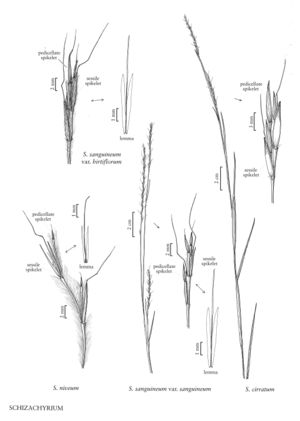Difference between revisions of "Schizachyrium cirratum"
FNA>Volume Importer |
FNA>Volume Importer |
||
| Line 7: | Line 7: | ||
|synonyms={{Treatment/ID/Synonym | |synonyms={{Treatment/ID/Synonym | ||
|name=Andropogon cirratus | |name=Andropogon cirratus | ||
| − | |authority= | + | |authority= |
| + | |rank=species | ||
}} | }} | ||
|hierarchy=Poaceae;Poaceae subfam. Panicoideae;Poaceae tribe Andropogoneae;Schizachyrium;Schizachyrium cirratum | |hierarchy=Poaceae;Poaceae subfam. Panicoideae;Poaceae tribe Andropogoneae;Schizachyrium;Schizachyrium cirratum | ||
| Line 20: | Line 21: | ||
-->{{Treatment/Body | -->{{Treatment/Body | ||
|distribution=Ariz.;N.Mex.;Calif.;Tex. | |distribution=Ariz.;N.Mex.;Calif.;Tex. | ||
| − | |discussion=<p>Schizachyrium cirratum grows on rocky slopes, mostly at elevations of 5000 feet or higher, from southern California to western Texas into Mexico, and is known from South America. It is an excellent forage grass. Plants in the Flora region differ from those in central Mexico in being essentially non-rhizomatous and in having glabrous rame axes and pedicels that are ciliate only on the distal half.</p> | + | |discussion=<p><i>Schizachyrium cirratum</i> grows on rocky slopes, mostly at elevations of 5000 feet or higher, from southern California to western Texas into Mexico, and is known from South America. It is an excellent forage grass. Plants in the Flora region differ from those in central Mexico in being essentially non-rhizomatous and in having glabrous rame axes and pedicels that are ciliate only on the distal half.</p> |
|tables= | |tables= | ||
|references= | |references= | ||
| Line 29: | Line 30: | ||
-->{{#Taxon: | -->{{#Taxon: | ||
name=Schizachyrium cirratum | name=Schizachyrium cirratum | ||
| − | |||
|authority=(Hack.) Wooton & Standi. | |authority=(Hack.) Wooton & Standi. | ||
|rank=species | |rank=species | ||
| Line 37: | Line 37: | ||
|family=Poaceae | |family=Poaceae | ||
|illustrator=Linda A. Vorobik | |illustrator=Linda A. Vorobik | ||
| + | |illustration copyright=Utah State University | ||
|distribution=Ariz.;N.Mex.;Calif.;Tex. | |distribution=Ariz.;N.Mex.;Calif.;Tex. | ||
|reference=None | |reference=None | ||
| Line 42: | Line 43: | ||
|publication year= | |publication year= | ||
|special status= | |special status= | ||
| − | |source xml=https:// | + | |source xml=https://jpend@bitbucket.org/aafc-mbb/fna-data-curation.git/src/f50eec43f223ca0e34566be0b046453a0960e173/coarse_grained_fna_xml/V25/V25_1623.xml |
|subfamily=Poaceae subfam. Panicoideae | |subfamily=Poaceae subfam. Panicoideae | ||
|tribe=Poaceae tribe Andropogoneae | |tribe=Poaceae tribe Andropogoneae | ||
Revision as of 21:35, 16 December 2019
Plants cespitose or shortly rhizomatous. Culms 31-75 cm, often decumbent, not rooting or branching at the lower nodes, glabrous, glaucous, sometimes purplish. Ligules 1-2.5 mm; blades 6-17 cm long, 2-4 mm wide, glabrous, without a longitudinal stripe of white, spongy tissue. Rames 4-6 cm, usually exerted, straight, often somewhat stiff, not flexuous, appearing linear; internodes straight, with a tuft of hairs near the base, elsewhere glabrous or ciliate on the margins. Sessile spikelets 8-10 mm; calluses 0.3-0.6 mm, hairs 0.5-1.2 mm; glumes glabrous or scabrous; awns 13-24 mm. Pedicels 3.5-5 mm long, 0.2-0.5 mm wide at the base, widening to 0.5-1 mm, straight, with a tuft of hairs at the base, distal 1/2 usually ciliate on 1 side, sometimes on both sides. Pedicellate spikelets 6-8 mm, about as long as the sessile spikelets, usually staminate, sometimes sterile, unawned. 2n = 20 (for var. cirratum).
Distribution
Ariz., N.Mex., Calif., Tex.
Discussion
Schizachyrium cirratum grows on rocky slopes, mostly at elevations of 5000 feet or higher, from southern California to western Texas into Mexico, and is known from South America. It is an excellent forage grass. Plants in the Flora region differ from those in central Mexico in being essentially non-rhizomatous and in having glabrous rame axes and pedicels that are ciliate only on the distal half.
Selected References
None.
